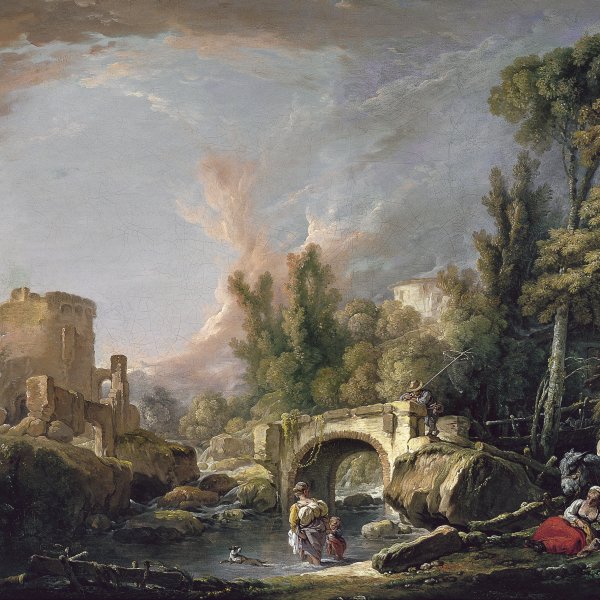River Landscape with an Antique Temple
Probably no other French artists so decisively shaped the style Louis XV and mid-18th-century art in general as François Boucher. His artistic virtuosity, the protection he received form the Marquise de Pompadour, and his appointment as Premier peintre du roi under Louis XVI (1765) brought him not only many commissions for Versailles and other royal residences, but also made him one of the most sought-after painters of his time. Besides important decorative works for castles and palaces in cities throughout Europe, Boucher made numerous designs and plans for the Gobelins tapestry works in Paris and the porcelain manufactory in Sèvres. As a pupil of François Lemoyne, he enjoyed great success with his mythological paintings, in which the allegorical statement usually took second place to the sensual, erotic effect of the naked female body. Like many of his amorous pastoral, genre, and boudoir pictures, the mythological scenes also became widely known through graphic reproductions.
Furthermore, throughout his long career, this commercially astute artist continued to paint landscapes. The two river landscapes were conceived as companion pieces and were probably originally owned by the still life and genre painter Jean Siméon Chardin. They are part of a series of paysages created in the late 1750s and early 1760s. Even at first glance, one can tell that the paintings are not topographically correct likenesses of particular locations, but fantasy landscapes composed of picturesque set pieces: in the first, a circular, antique temple, a creek, windblown bushes and trees, an archaic stone bridge, a few sheep an goats; in the second, a ruined medieval tower next to a rocky stream spanned by a stone bridge, a small wood, and in the background, a farm in front of a rocaille-shaped cloud formation. The painter has peopled both works with set figures: a fisherman watching a woman resting with her donkey; a mother, her child and a dog wading through the stream; and a shepherd with a basket of flowers attempting to coax a girl resting in the shadows into a pastoral tryst. The impression of a stage set -Boucher worked for a long time as a set decorator- is increased by the artificial colouring. Additionally, a glistening light, streaming in from the left like a spotlight, illuminates various parts of the composition.
For a long time, it was exactly this portrayal of an artificial type of nature that contributed to the painter's success. On the one hand, Boucher exaggerated the town dweller's idea of idyllic nature; on the other, he gave the viewer the chance to identify individual architectural elements in the landscapes. For instance, as the model for the small circular temple he chose the Sybilline Temple in Tivoli, which he had sketched during a trip to Italy in 1730. This historic ruin, inserted into an additive ideal landscape, gave the work additional charm. Boucher quite clearly was playing with the academic demand that painters ought to study nature, as the art theorist Roger de Piles had stated at the beginning of the century: "The studies of the landscape painter therefore consist of the search for beautiful effects in nature, which they perhaps might have need of in composing their tableaux. Above all it is a question of making a good selection among these beautiful effects of nature." In his painting The Painter in his Studio. Boucher programmatically rendered the idea that every landscape painter must follow the basic rules of the étude du paysage. If ones compares the painting on the easel with the drawing in the open sketch-book next to it, it becomes clear that the final composition derives from the artist's imagination. The painter takes what he has drawn according to nature and fuses the objects together in the painting in whatever way he pleases. Boucher, who was as free as he was virtuoso in the way he used his repertoire of compositions and objects, was almost able to serially produce landscapes in the style champêtre. So, for example, there are numerous compositional and thematic correspondences between the River Landscape with an Antique Temple and the Landscape with Waterwheel and Temple (1743).
Nevertheless, from the 1760s onwards and despite the fact that the artist continued to enjoy favour among collectors and those commissioning works, contemporary art critics increasingly questioned his understanding of art and nature. At the Salon of 1761, Denis Diderot still admired two landscapes painted for Christian IV, Duke of Zweibrücken. He was excited about the artistic quality: "The painting is gripping. One returns to it. It has such an inimitable and rare extravagance. There is so much imagination, effect, magic, and ease!" But he also already felt they were lacking in truth: "What a conglomeration of disparate things!" When Boucher exhibited various pastorals and a paysage at the Salon of 1765, Diderot's scepticism changed to rejection: "I defy you to find anywhere in the countryside a single blade of grass resembling the ones in his paintings. And what a confusion of things there are piled on top of each other, so out of place, so disparate. It is not so much a painting by a man of reason as a lunatic's dream. I dare say that he has never known reality; I dare say he has never for an instant seen nature."
Boucher's landscapes are nowadays regarded as the ultimate in the petit goût, which was held responsible for the decline of French painting. The new protagonists of landscape painting were Hubert Robert and particularly Claude-Joseph Vernet. In their work, the sublime landscape replaced the picturesque idyll.
Martin Schieder









